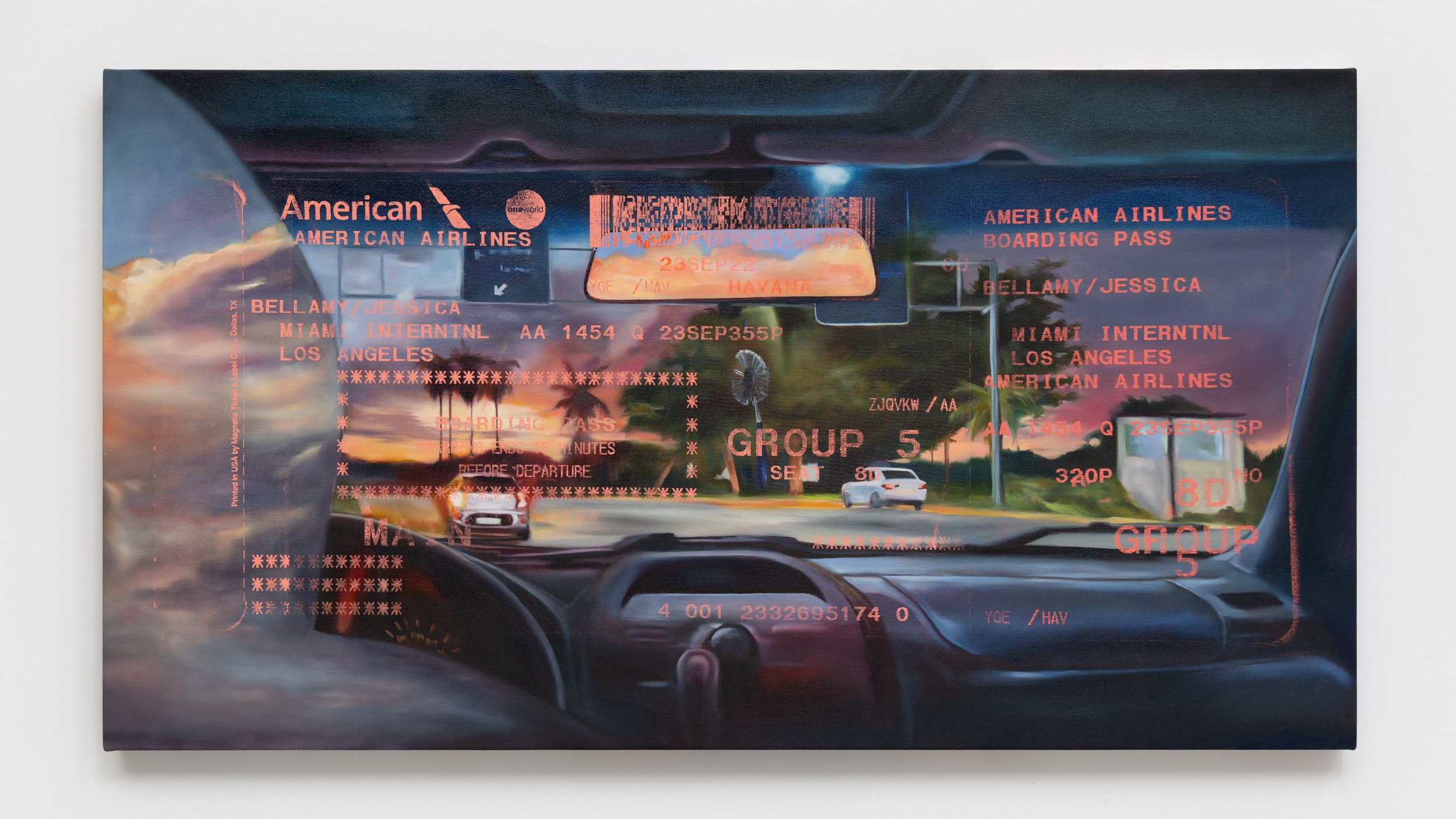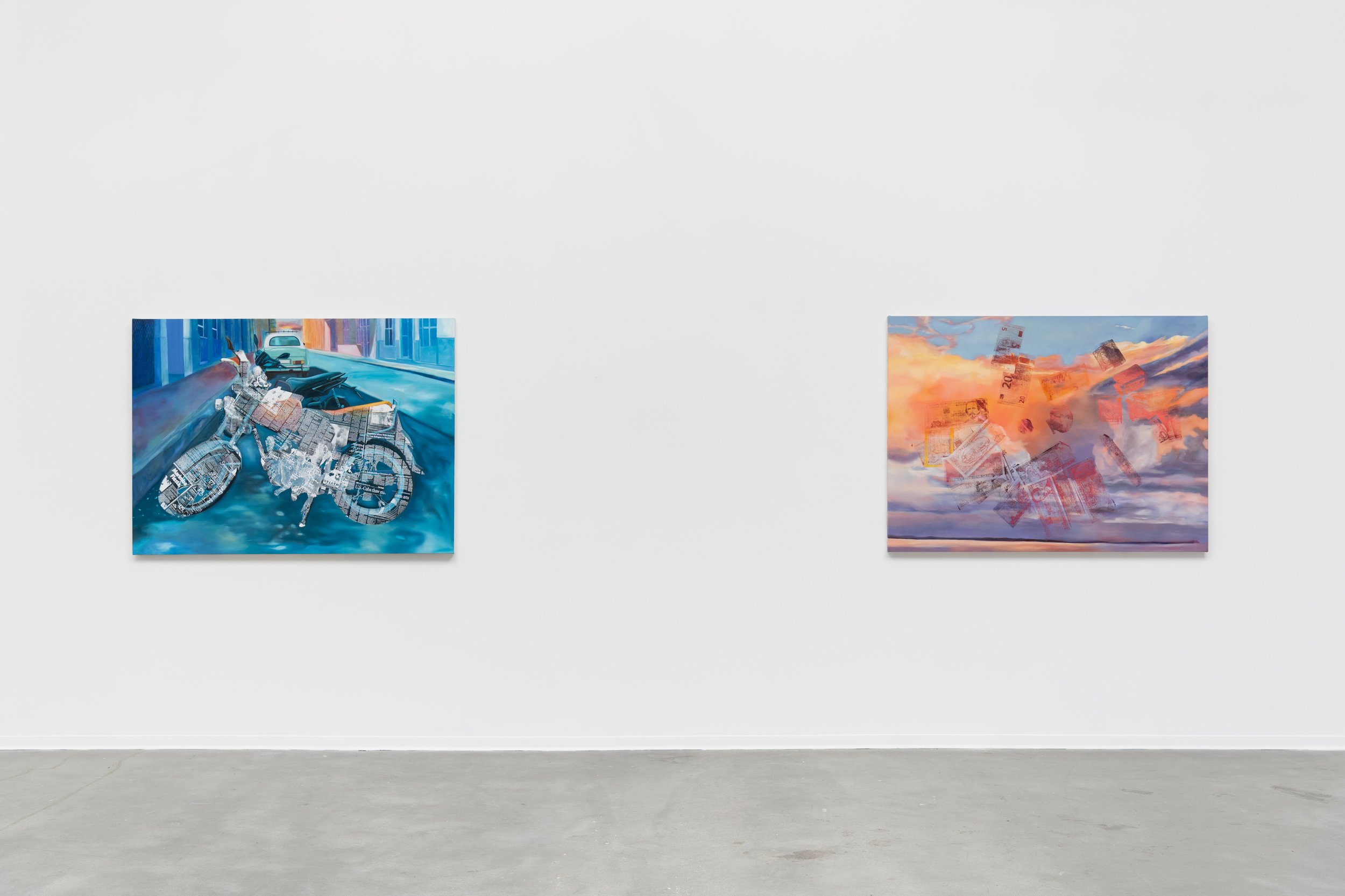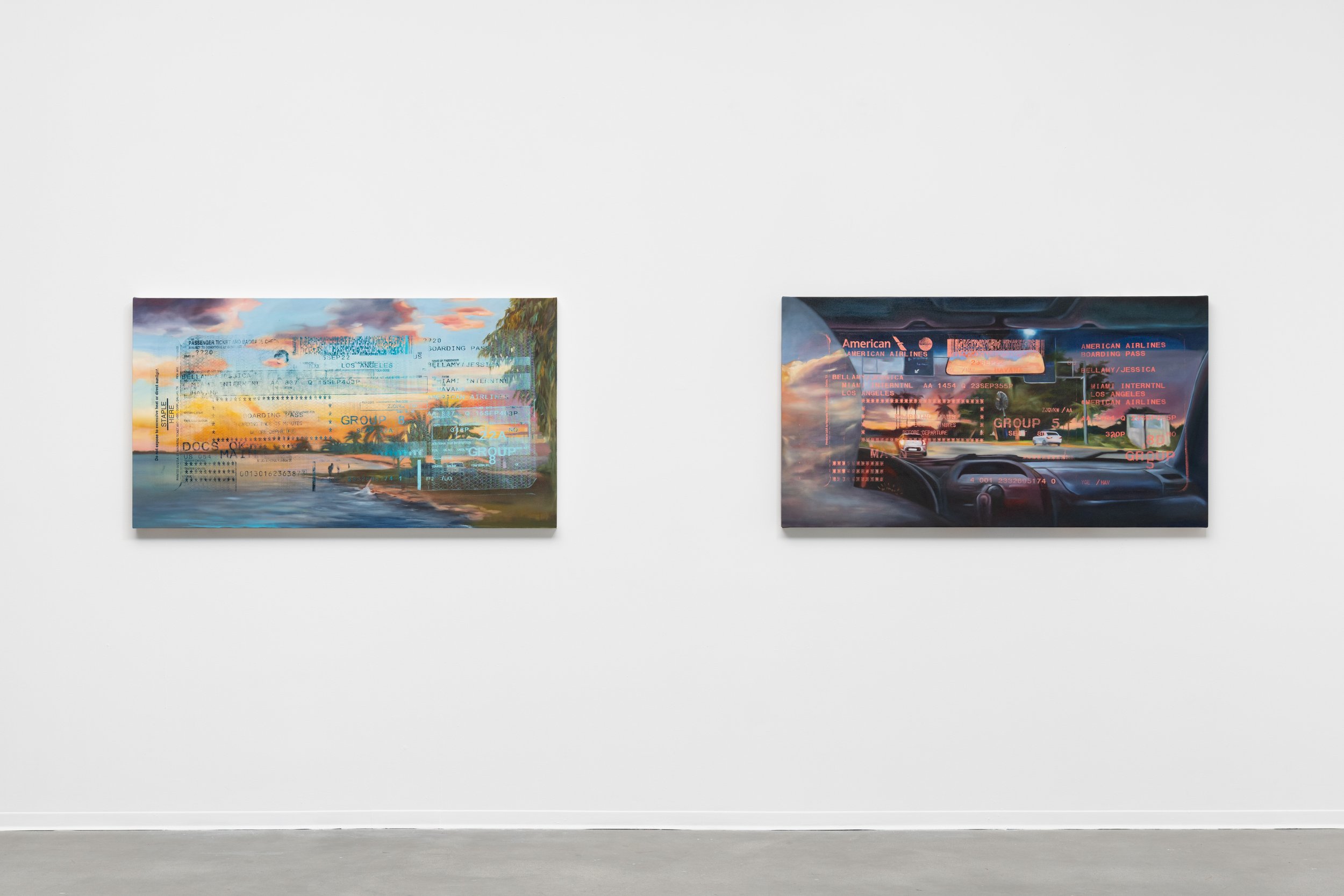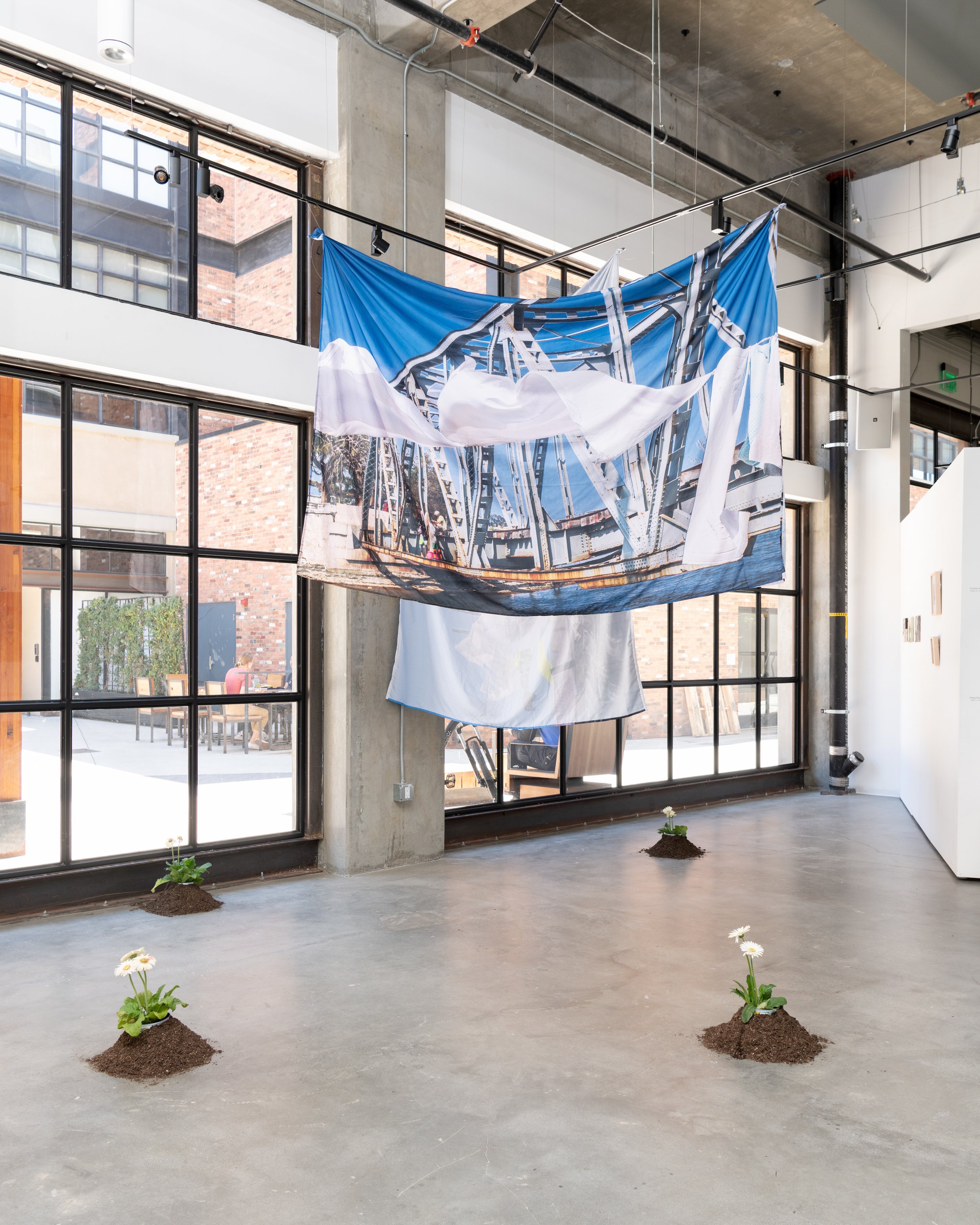American Airlines Passenger Ticket II (After Warhol), oil on canvas, 2023, 32” x 59” Jessica Taylor Bellamy.
Vanities Come to Dust: From Havana to Los Angeles, With Love
Co-curated with Ana Briz
USC Macomber Travel Grant Exhibition
1262 Palmetto St, Los Angeles, CA 90013 (Arts District)
August 4 - 19, 2023
Gallery Hours Wednesday through Friday, 12pm - 5pm or by appt
Essay by Ana Briz
Vanities Come to Dust: From Havana to Los Angeles, With Love (August 4 - 19, 2023) features a new body of work by multidisciplinary artist Jessica Taylor Bellamy on the occasion of her USC Macomber Travel Grant. Bellamy, whose work explores the symbiosis of illusions and reality, visited Cuba in the fall of 2022 as an investigation into what distances and brings together Cuba and the United States. Interested in exploring various forms of exchange between the island and the U.S., Bellamy’s paintings for the exhibition are a layered examination of the migrant, medical, financial, and aesthetic exchanges between Havana, Cuba and Los Angeles, California. From scarce newspapers and weather reports to foreign automobiles and boarding passes, this body of work archives ephemeral records of time spent on this planet, isolating fragmented ephemera from their everyday and enlarging them so that their impact is visualized and more readily felt.
Bellamy’s visual language works through incongruities to make sense of the paradoxes of life. She brings two sides of the same coin into our plane of vision, placing opposites atop one another into a palimpsest worth teasing out. Returning to the island over fifty years after her paternal grandmother, father, and uncle immigrated to the United States in 1967 by way of Miami, Bellamy confronted the fact that her life experience as she knows it was shaped decades ago by a series of seemingly random events. In Cuba, Bellamy came to understand the everydayness of diaspora from a different vantage point, where the mundane and forgotten clashes with the idyllic and fantastical until they merge into one paradoxical reality.
Cuba’s picturesque sunsets and tropical landscapes are made uneasy, less inviting in her paintings. Lightning strikes in a stormy scene, Tonights Entertainment (Stormy combination pill pack) (2023), and coquina shells rain down the land to populate the beaches where they can be found up and down the California coast. Coquinas are also found in other parts of the world, such as on the shores of the Atlantic. Sometimes when big storms or hurricanes are set to pass by the Caribbean or their not-so-distant Floridian neighbor, all there is to do is shelter in place and count the days (and your blessings). Passing the time by counting shells, Bellamy’s calendar of coquinas also references the familiar birth control pill casing that delineates the 28-day menstrual cycle.
In another work, A Subspecies of Journalism (2023), Bellamy depicts the streets of Havana as American tourists know it: buildings of every color line the sidewalks and a classic 1950s Chevrolet in an equally vibrant hue makes its way down the street. Of course, only tourists utilize the refurbished vintage taxis. Cubans, more or less, make do with motorcycles or other forms of transportation. In A Subspecies of Journalism, the parked moto is engulfed in various clippings from the Los Angeles Times whenever Cuba is mentioned or reported on. Screened off behind layers of text, iconic vistas sought after the tourist economy are reprocessed through a lens informed by the history of U.S. imperialism on the island. Reclaimed through this practice, Bellamy’s paintings offer new ways of engaging with Cuba today.
As typical of her practice, Bellamy scoured the country for newspaper accounts of the politics, weather, and culture of Cuba, only to find that unlike in Los Angeles, newspapers in Havana, Trinidad, and Matanzas are scarce commodities. They are not available in any stores, restaurants, or hotels. Presses do not provide local deliveries. At times, street vendors will sell old, stained copies with missing pages. According to Amnesty International in 2016, at the time when the U.S. began to end hostile relations with Cuba, only 25% of Cubans use the internet and only 5% have access to it in their homes. For those with access to get online, the government restricts what sites can be accessed and what can be shared on the web. For these reasons, many citizens of Cuba cannot find simple answers to their most basic questions, such as for example what countries require visas to visit.
For Vanities Come to Dust, Bellamy has invited four Matanzas-based artists to participate in the exhibition: Helga Montalván (1976-), Adrian Socorro Suarez (1979-), Ernesto Millan (1973-), and Jorge Y. Salomón (1987-). Collectively, their works present a shared visual language to examine tensions between globalization, consumerism, and ancestral traditions. Envisioned as a social practice project, Bellamy cultivates an artistic community in the space of the gallery to foreground the work of artists intimately working through the very questions that motivated her research in Cuba.
The exhibition’s title draws from Joan Didion’s Miami (1987), wherein Didion famously wrote at the outset of the book: “Havana vanities come to dust in Miami.” Writing in the late ‘80s, Didion examines Miami as a major Cuban settlement with a continuously growing population of migrants and asylum seekers since 1959 when the Cuban Revolution succeeded in overthrowing the U.S.-backed military dictator Fulgencio Batista. This led Fidel Castro and later the Communist Party to take control of the island, nationalizing industries such as oil refinery and the important agriculture of sugar, which were both industries previously owned and monopolized by the U.S. Unhappy with this and the rise of communism in Cuba, the CIA planned to overthrow Castro, leading to the failed Bay of Pigs invasion. Major exodus began shortly after this such as with Operation Peter Pan, which brought over 14,000 unaccompanied minors to the states in the ‘60s such as the artist Ana Mendieta, and the Mariel boatlift, which mass emigrated over 125,000 Cubans to Miami in 1980. As an analysis of the socio-political relations between Cuba and the U.S. post-Cuban Revolution, Miami contends with how exile and diaspora can transform a city once the dust settles in place. In this exhibition, the dust never permanently settles, and instead we are offered the opportunity to speculate about the past, present, and future of Cuba’s relationship with Los Angeles.
The way Miami’s image, culture, history, and people have been disseminated in mass media is not dissimilar to Los Angeles. As someone who grew up in Miami in the early aughts, I knew personally of the vanities Didon referred to, as well as how they came to rest in a city that is arguably more Caribbean and Latin American than anywhere else in the United States. Cuban exile y la lucha are palpable in Miami. This rings true today as it did in the 1960s and 1980s, and yet the historical struggle against socialist government has transformed exilic Cubans into some of the most dangerous proponents for conservative and Far Right policies that infringe upon basic human rights. The likes of Marco Rubio and Ted Cruz today campaign on immigration detention and deportation, shrinking immigrant rights, anti-abortion, and anti-LGBTQ rights. Florida is a hotbed for oppressive government.
On the other hand, Los Angeles vis-à-vis Hollywood and the major film industry in the region is envisioned as a progressive haven with beautiful weather and even more beautiful people. And yet, at the time of this writing and exhibition, we are witness to a major labor strike led by the Writers Guild of America who are now joined by the Screen Actors Guild and the American Federation of Television and Radio Artists (or SAG-AFTRA). Increasing precarity and corporate greed by putting profits over people has brought forward this strike, illustrating exactly how as a nation we love and appreciate our Western film industry but not the creatives who labor over it.
Andy Warhol knew this well in the 1960s, summing Hollywood up as definitively American and everything he ever wanted. Afterall, nothing was more Pop than Hollywood. “I love Los Angeles. I love Hollywood,” he once said in perfect Warholian fashion, “Everybody’s plastic, but I love plastic. I want to be plastic.” Life in (micro)plastic? According to Warhol (and Barbie), it’s fantastic. Bellamy recognizes this intersecting history of art, commerce, and culture as well, taking a cue from Warhol’s SAS Passenger Ticket 20 (1968) in American Airlines Passenger Ticket 1 (after Warhol) (2023). Both Warhol and Bellamy share similar processes in their artistic practices by including silk screen prints of archival and iconographic materials in their paintings. The mundane and everyday is enlarged to monumental proportions, transforming vanity and ephemeral moments of American culture into socio-political reflections of the way things are and where they are going.
Ana Briz
Install shot of Vanities Come to Dust: From Havana to Los Angeles, with Love
Install shot of Vanities Come to Dust: From Havana to Los Angeles, with Love
Install shot of Vanities Come to Dust: From Havana to Los Angeles, with Love
Install shot of Vanities Come to Dust: From Havana to Los Angeles, with Love




